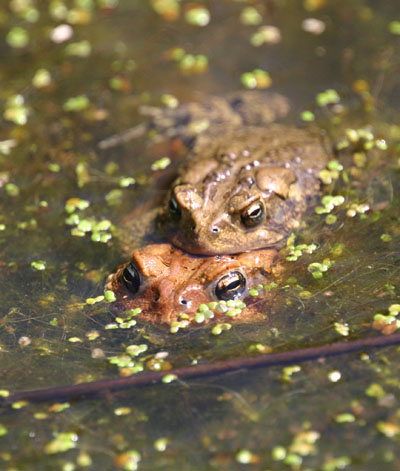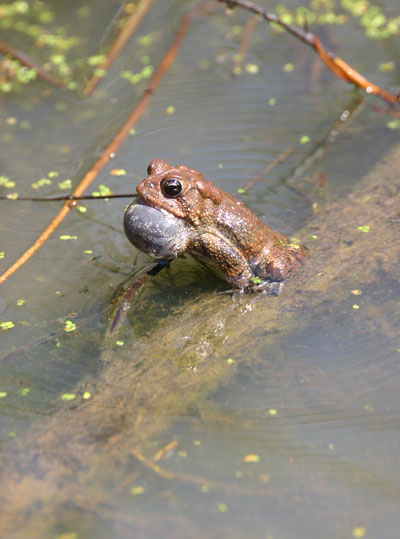 If you’re the least bit familiar with frogs and toads, you know that anything but the most cautious approach to any pond where they hang out will send them sailing off the bank into the cover of the water, or vanish beneath the surface if they’re in the water in the first place. This, however, is a set of rules that does not apply to mating season.
If you’re the least bit familiar with frogs and toads, you know that anything but the most cautious approach to any pond where they hang out will send them sailing off the bank into the cover of the water, or vanish beneath the surface if they’re in the water in the first place. This, however, is a set of rules that does not apply to mating season.
On approaching the little drainage pond in the nearby park yesterday, the water was unnaturally agitated all over – ripples and wavelets dotted the surface, very odd for a minuscule fish-free lily pond in a meadow. Yet it was also self-explanatory if the cacophony of amphibian calls that emanated from it were taken into account. I crept closer warily, and pointlessly, since the procreation drive of the inhabitants was distinctly overwhelming any self-protective drive and no one seemed too inclined to pay any attention to me. The long lens confirmed my suspicions as I looked closely at the orgiasts – these were all American toads (Bufo americanus) and not frogs at all. Normally toads aren’t very aquatic, spending most of their lives on land, and their coloration is more suited to this; blending in they weren’t.
Whoever coined the term “dogpile” might have benefited more from seeing amphibians in the spring – they tend to stack up in an overeager and somewhat lurid way, which was responsible for at least half of the disturbances in the water. If any particular toad seemed to be struggling at all, chances were that at least two others could be found, if one looked close, submerged beneath the first by the combined weight. Others pursued one another in brief spurts (sorry,) selecting their prom dates in a manner not immediately evident to me.

Still others languished in midwater, perhaps unlucky, perhaps exhausted – I can’t say that I would know what a toad’s ‘glow’ looked like if I saw it, so I’ll just leave my amateur naturalist’s shortcomings out there for comment. As I watched, a lone toad hopped hurriedly across the paved footpath and down the embankment into the water, apparently late to the party – if the activity I’d already observed was any indication, they were definitely all out of dip.
 Here’s something that I didn’t notice until I was proofing the images after arriving home. I captured several toads perched in obvious locations and calling eagerly, but note the ripples surrounding this one, produced by the frequency of its calls. I have to say that this was subtle, because I missed it entirely even while taking numerous frames of several individuals. Then again, looking at the apparent point of origin of the ripples, maybe something else is at work here – do toads like beans? Maybe the calls are actually cover sounds, like how we cough loudly sometimes to disguise our, uh, nether emanations (yeah, like that ever works.) But then again I don’t see bubbles, so let’s stick with the mating calls as the culprit.
Here’s something that I didn’t notice until I was proofing the images after arriving home. I captured several toads perched in obvious locations and calling eagerly, but note the ripples surrounding this one, produced by the frequency of its calls. I have to say that this was subtle, because I missed it entirely even while taking numerous frames of several individuals. Then again, looking at the apparent point of origin of the ripples, maybe something else is at work here – do toads like beans? Maybe the calls are actually cover sounds, like how we cough loudly sometimes to disguise our, uh, nether emanations (yeah, like that ever works.) But then again I don’t see bubbles, so let’s stick with the mating calls as the culprit.
The toads weren’t the only ones feeling the spring weather. While wandering off the path to examine a new beaver dam, I became aware of a lot of insecty activity at my feet, confined to a small area of last year’s dried grasses for some reason. These eastern boxelder bugs (Boisea trivittata) were scampering busily across the ground litter, challenging me to nail sharp focus with a macro lens as I followed them on my knees. I had two ‘matched’ (or latched) pairs to work with, and with one pair, the larger specimen would stop occasionally and make the apparent attempt to disengage from the smaller, without luck (producing some nice blurry frames of course – the only decent images I achieved came from their pauses.)

If you’re up on your aposematic coloration theory, you’d recognize the pattern here as likely indicating that these boxelder bugs taste bad (either that, or they’ve developed a mimicry of another species that does – that’s Batesian Mimicry.) Sure enough, boxelder bugs produce a rank smelling and tasting substance if disturbed, according to my sources – I did not lick these myself, despite the obvious temptation (the toads neither.) The red compound eyes are quite distinctive, of course, but if you look close you can see that the secondary, simple eyes are also red. How come humans have never developed red eyes? It not only would be cool, it would virtually guarantee no one would pick a fight with you. Maybe we need to start our own selective breeding programs…




















































